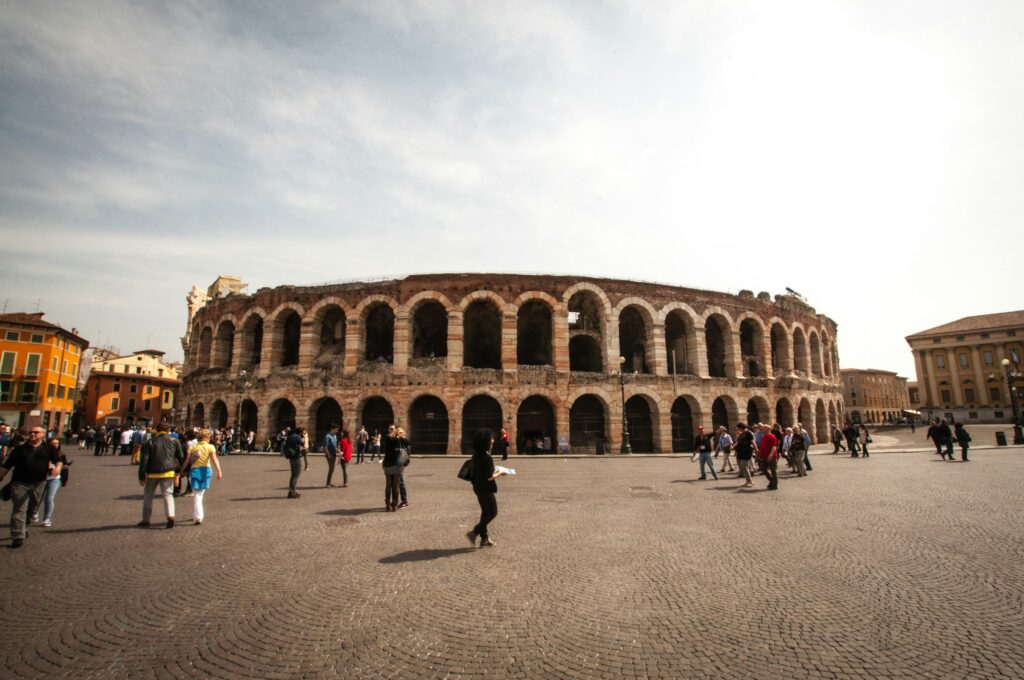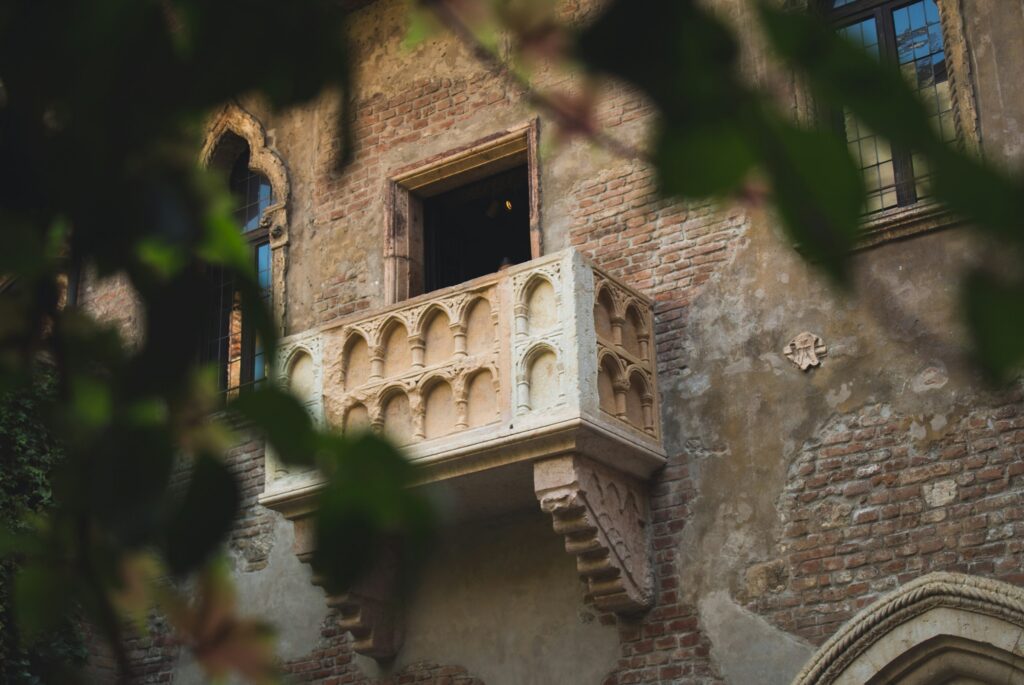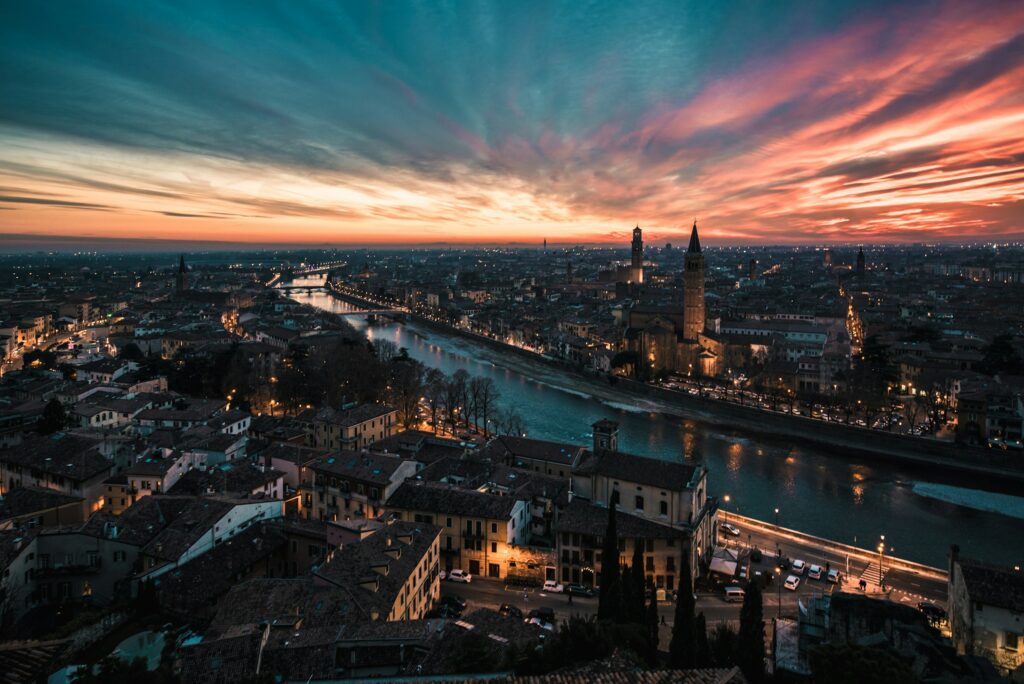Table of Contents
Verona, Italy, isn’t just about Shakespearean romance and operatic arias. This enchanting city boasts a history as rich and layered as its tiramisu. This is Verona, a living museum where every cobblestone narrates a chapter in its 2,500-year-old story. Prepare to delve into a journey through time, where we’ll meet emperors, tyrants, and tragic lovers amidst a backdrop of empires rising and falling like curtains on a stage. Buckle up, history buffs and romantics alike, because we’re about to explore the captivating story of the history of Verona! And let’s be clear here: We’re giving you the history book highlight reel, because with a city thousands of years old, there’s no way to cover it all!
Born by the River, Forged by Empires (6th Century BC – 5th Century AD)

Imagine a bustling trading post by the Adige River, inhabited by the mysterious Euganei tribe. In the 6th century BC, they were swept away by the Gauls, who renamed the settlement “Verona.” Fast forward to 89 BC, and Julius Caesar himself arrived, transforming Verona into a Roman colony. Think impressive amphitheaters, bustling forum, and legions marching through cobbled streets. In fact, the famous Verona Arena (or Verona Amphitheater) was built in 50 BC, making it even older than the Roman Coliseum, AND it’s still in use today! The poet Catullus was even born here, channeling his love for Verona into timeless verses.
In fact, besides the famed Arena, there’s still many original Roman structures and construction still standing in use to this day. The Roman Theatre of Verona was built during the first century AD, however it fell into disrepair. In the 8th century a wealthy citizen by the name of Andrea Monga essentially bought the theatre to remove all the construction done over the site, and restore it to its former glory. As you walk through Verona you’ll also notice the Porta Bosari, a gate in the old Roman city walls, as well as the Porta Leoni, the Arco dei Gavi, and many original Roman features still in use over 2,000 years later.
Of course, we all know that nothing gold can last. By 300 AD Rome was beginning to fracture and come under attacks from outside states, and by the year 500 AD, ancient Rome had collapsed. Verona was no longer a Roman city, and power over the city was changing hands. Enter the Germanic tribes, like the Ostrogoths, who swept in during the 5th century AD. Think not of barbarians, but of a vibrant exchange of ideas, where Roman structures now mingle with Gothic influences. Verona remained a crucial crossroads, witnessing clashes of power and cultural exchange. Think of it as the “Game of Thrones” of its time, but with less dragons and more togas.
Medieval Mayhem: Feuds, Scaligers, and a Star-Crossed Tragedy (5th Century AD – 15th Century AD)

This should come as exactly zero surprise but… the Middle Ages in Verona were anything but peaceful. The city became a pawn between powerful families vying for control. The feuds were as dramatic as any Shakespearean play, with alliances shifting like sands in the desert. In the midst of this chaos, rise the Scaligers, a dynasty that leaves an indelible mark on the city’s soul. From the 13th to the 15th centuries, they rule with an iron fist, their towering castles (Castelvecchio and Scaligero) standing as imposing testaments to their power. They patronize the arts – Dante himself finds refuge here! – and transform Verona into a cultural hub. Yet, their reign is not without its darkness, as whispered tales of intrigue and bloodshed weave through the city’s fabric.
Speaking of Shakespeare, it’s during this period that the legend of Romeo and Juliet is said to have unfolded. While historians debate the historical accuracy, the legend of their star-crossed love, immortalized by Shakespeare, remains deeply embedded in Verona’s identity. From their supposed tombs to the charming Casa di Giulietta, their tragic tale continues to resonate with hearts worldwide, adding a touch of melancholy romance to the city’s atmosphere.
The most famous structure still standing and in use from the medieval period of Verona’s history has to be the Basilica of San Zeno. It was constructed over a 4th century shrine to St. Zeno, the patron saint of Verona, and it’s bell tower is even mentioned by Dante in Divine Comedy. However, despite religious significance, much of it’s fame comes from the tradition that it was the true marriage place of Romeo and Juliet! (Have you noticed how much of the history of Verona keeps circling back to a couple teenagers in love?)
Venetian Velvet and Napoleonic Turmoil (15th Century AD – 19th Century AD)
In the 15th century, the mighty Venetian Republic swept in, bringing a period of relative stability and artistic flourish to the history of Verona. Imagine ornate palaces lining the streets, the Grand Canal replaced by the Adige, and gondolas replaced by…well, horses probably. Venice nurtured trade and the arts, making Verona a cultural gem. Think Renaissance masters like Veronese painting their masterpieces while sipping on local Bardolino wine.
Verona changed hands several times during this period. Emperor Maximillian I (who ruled from 1490-1516 AD), desperately tried to make Verona the capital of the Italian sector of his German kingdom. However, with the Treaty of Brussels in 1516, Maximillian gifted the city of Verona to his grandson (what a generous gift, we might add), Charles V of Spain. Charles then gave Verona to France, who finally returned it back to Venice. This is when Venice made most of it’s investments and improvements to the city, as they saw Verona as a stronghold in mainland Italy. Verona’s population rose to 55,000 people, a significant size for it’s time, before a plague in 1630 AD reduced it to nearly 20,000 inhabitants.
Napoleon, history’s self-proclaimed emperor, marched in during the 18th century, disrupting the Venetian reign. Verona played a key role in the Napoleonic Wars, its mighty fortifications resisting his advances. Imagine cannons booming, soldiers clashing, and the city holding its breath for victory. Eventually, on Easter Monday in 1797, the people of Verona itself rose up and drove Napoleon and the French out of the city. This caused Napoleon to sign a treaty dissolving the Venetian Republic, which passed Verona over to the Austrians. However, in 1805, Verona was returned to Napoleon as part of his Kingdom of Italy… only to return back to the Austrians in 1814 with Napoleons defeat.
Modern Verona History (19th Century – Present Day)

The 19th century saw a surge of Italian nationalism, with Verona participating in the unification movement known as the Risorgimento. Think passionate speeches, daring uprisings, and finally, in 1866, Verona joining the newly formed Kingdom of Italy. The city embraced its modern identity, developing industries while holding onto its rich heritage. Since then, the history of Verona has been much, MUCH, more stable. Italy has remained mostly unified with only small territory changes over the last 150 years, becoming what we now understand as Italy in 1946. And now Verona stands as one of the most iconic cities in one of the most culturally impactful cities in the world. Thanks to Romeo & Juliet, no matter how true the story may be, nearly everyone knows a little bit about the City of Love.
Today, Verona pulsates with life. Tourists flock to see the iconic Arena, home to world-renowned opera performances under the stars. Foodies devour pasta dishes on charming piazzas, while history buffs wander through Roman ruins and medieval alleyways. The city retains its romantic charm, offering a glimpse into its captivating past while embracing its dynamic present. The history of Verona is a topic with endless rabbit holes to truly understand how the city came to be what it is today.




